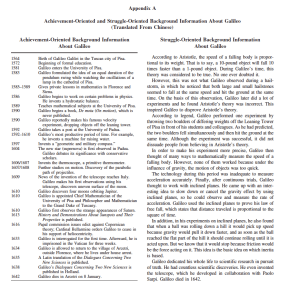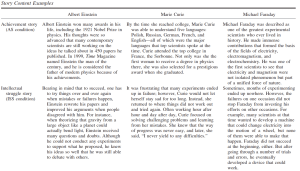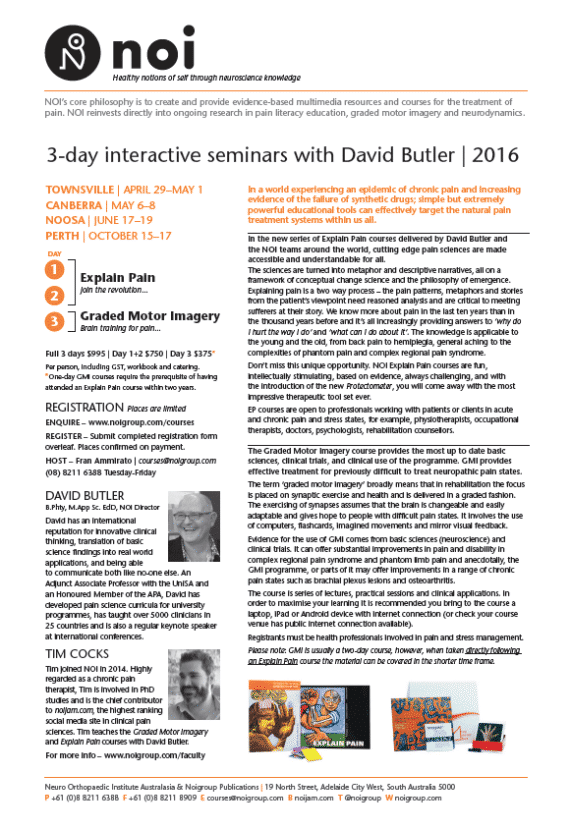It’s not you, it’s me
Novel educational strategies and research always grabs our attention, and a recent paper highlighted by Quartz did just that:
Teens do better in science when they know Einstein and Curie also struggled
“Ninth- and 10th-grade students in low-performing New York City schools who read about Albert Einstein’s struggles, including multiple school changes and trouble convincing others that gravity from a large object like a planet could actually bend light, performed better in science than a control group who learned only about what the scientists achieved.”
In the paper referenced in the Quartz article – Even Einstein Struggled: Effects of Learning About Great Scientists’ Struggles on High School Students’ Motivation to Learn Science, Lin-Siegler et al (2016) (sorry, behind a paywall) start out by asking 9th and 10th graders “what kind of people can be scientists?” The responses were “egalitarian” and likely to “garner approval from teachers and researchers” – responses such as “any person who has a spark of curiosity in himself or herself”, or “people who can work hard”.
However, Lin-Siegler at al (2016) report that many students had trouble imagining themselves as scientists – “because I don’t get the best grades in science class right now. Even if I work hard, I will not do well”. The authors suggest that this disconnect between students’ comments about scientists and comments about themselves is problematic:
“Students with the belief that success in science requires exceptional talent often avoid science classes, give up easily when they experience setbacks in their experiments, and often feel threatened by students who thrive in science classes”
Malleable beliefs
On the positive side, the authors state that beliefs about science and scientists can be challenged and altered:
“…a growth mind-set can be directly taught to students. For example, a growth mind-set can be fostered by providing students with scientific articles or films about the malleability of intelligence or with physiological evidence for how the brain is like a muscle and can be developed with effort”
With this in mind, they set out to to try and tease apart just what aspect of teaching students about effort (vs natural ability) might be responsible for promoting more productive work and success in science learning:
“…we developed an innovative approach to convey a growth mind-set message through highly respected role models’ struggles (life and intellectual). We compared this approach with presenting stories about scientists’ achievements, which exemplify a fixed mind-set. We then examined how these instructional approaches affect students’ motivation and performance in science classes.”
The experiment
A total of 472 9th and 10th graders participated in the study and the authors found:
“…exposing students to scientists’ struggle stories improved their science-class performance (in terms of class grades), whereas exposing students to achievement stories did not. Not only did class performance not improve, reading achievement stories might actually be harmful, as reflected in our results.
“Second, students respond to the presence of struggle in the scientist stories, but whether the struggles centered on life or intellectual struggles did not seem to alter the effects of the stories on science-class performance.
“…our intervention was most beneficial for students who are low performing. For low-performing students, the exposure to struggling stories led to significantly better science-class performance than low-performing students who read achievement stories.”
“Fourth, a significantly larger number of students who read about scientists’ struggles (intellectual or life) felt connected with the stories and scientists than did students who read about scientists’ achievements.”
Lessons for Explain Pain?
I’m going to posit two, speculative, theories to consider:
- Explain Pain, in many ways, is a form of science education and it is conceivable that patients receiving Explain pain interventions hold similar beliefs about their ability to understand and learn pain science.
- Perhaps on a more abstract level, there is an analogy between students believing that being a great scientist requires innate and exceptional talent and patients believing that recovery of pain requires some special, innate ‘healing ability’.
I have heard statements from patients that, I think, indicate this kind of thinking, for example (1.) “I’ll never understand this brain and pain stuff – I was hopeless at science in school”, or (2.) “I know (insert name of famous sportsperson) is back playing after the same injury – but just look at them – they’re superhuman”.
The findings of Lin-Siegler et al (2016) therefore suggest to me that Explain Pain interventions might be enhanced by more general stories that highlight the struggles of scientists to understand pain, and, more specific stories that highlight the struggles of people who have overcome pain, rather than their achievements. Knowing that others have recovered from persistent pain might provide hope for some, but it seems like the details (perhaps the commonality?) of their struggle to do so might be more important.
An emerging theory
Digging into Lin-Siegler et al (2016) and some earlier work (Hong and Lin-Siegler 2012) from the same author, another speculative lightbulb lit up – the idea of a ‘growth mindset’ contrasted with a ‘fixed mindset’ (Lin-Sigler 2016) brought to mind notions of emergent and linear thinking that we have covered before. This was strengthened by looking at the examples used in both papers to contrast ‘struggle stories’ with ‘achievement stories’. Take, for example, the material used in Hong and Lin-Siegler (2012):

The achievement background information for Galileo is a linear list of achievements over time, whereas the struggle-oriented background information is a narrative with, I would argue, emergent themes such as multiple interacting influences, surprising results and circular causality. Similarly, the examples provided in Lin-Siegler et al (2016) show, I think, a similar distinction:

Once again, the achievement stories are quite linear, essentially lists of achievements in roughly chronological order, while the struggle stories have a more emergent flavour, with notions of working on and solving multiple challenges at once, dealing with knock backs and failures while continuing to refine ideas, and multiple, ongoing efforts to succeed.
There is a well documented theory that suggests that students struggle with learning many science concepts because they attempt to understand emergent phenomena (diffusion, electricity, natural selection, heat flow) using a framework for linear phenomena (wound healing, cell mitosis, moon phases, photosynthesis), and that these misconceptions are very robust and resistant to instruction. At the same time however, there is evidence that teaching students general emergent ideas (providing an emergent schema) helps students to reconceptualise and understand these scientific concepts.
Perhaps there is just a hint of that occurring in Lin-Siegler’s work as well. The overall suggestion then might be that appropriate struggle stories could help people learn about pain by
– Changing their beliefs about their ability to learn science
– Allowing them to feel more connected with the Explain Pain material
– Challenging their beliefs about recovery from pain
– Helping to establish an emergent schema.
Thoughts, questions and comments, as always, welcome below.
-Tim Cocks
Hong H-Y and Lin-Sigler X (2012) How learning about scientists’ struggles influences student’s interest and learning in physics. Journal of Educational Psychology 104 (2) 469-484
We’re emerging into an action packed Australian teaching tour in 2016. Click on the image below, or the location links, for details:

Townsville: April 29-May 1 EP & GMI
Canberra: at the Australian Institute of Sport May 3-4 MONIS, May 6-8 EP & GMI
Adelaide: May 14-15 Pain, Plasticity and Rehabilitation
Noosa: June 17-19 EP & GMI
Perth: October 15-17 EP & GMI

Pain education can be very brief and simple. I liken imaging changes to patina on antique furniture (“function unaffected, but value increased” – usually gets a laugh).
When it comes to education, brevity and simplicity will always trump lenghty, detailed explanations. Why? See: Law of Reversed Effort (Coue).
So I’m careful not to spend more than about 5 minutes on EP. And if I remember, I use hypnotic principles to make sure the message really sinks in. Things like altering tone, pausing before the important point, gaze induction etc.
Hi Cam,
I think your five minute simplistic, laughter seeking formulaic prescription hints at health practitioner omnipotence and denies vast research domains in educational psychology, conceptual change science, explain pain science and the neuroscience of learning. It’s not what NOI teaches and I wouldn’t call it Explain Pain.
David
I used to get clients to watch one of Lorimer’s Youtube videos (multimedia) and then see what they thought (feedback, check understanding).
Then I’d have a big laminated diagram of the brain/spinal cord/periphery that I could to draw on (more multi-media), showing how nerves could becomes sensitized through fear, and that these changes could occur at the 3 different levels. Then I explained how the sensitization could be undone, and I’d rub out the different colour pens from the laminated diagram. It took about 30 minutes the whole thing.
But I’ve just kept whittling away – and now I’m at 5 minutes and it appears to work just as well. If someone doesn’t make progress, I give them the full run down, but I prefer doing the minimal amount of work wherever possible. I’m pretty sure I understand conceptual change well, because I’ve studied hypnosis. Education isn’t something I’ve studied.
The ‘Omnipotent Practitioner’ is a role I play. I play the role because it makes clients feel very safe. I’d encourage all clinicians to adopt such a posture, because it works.
Sorry to include humour. I’ll stop that.
Good idea to remove humour if you only have a five minute recipe. It is worth studying aspects of education for Explain Pain skills and conceptual change science is quite different to hypnosis although aspects of hypnosis may enhance Explain Pain outcomes. Omnipotence along with superficial explanations breeds reliance and addiction to health practitioners. That’s how its been for years with 1 in 4 with ongoing pain. Some groups encourage it, but it is the polar opposite of the philosophy of NOI.
David
Thanks for Struggle Street Tim,
I wanted to come back to it, as we got off topic above.
I think that this is important stuff for Explain Pain. If learners believe that success in science requires exceptional talent and thus they should avoid science, or could feel threatened by it if they don’t have such a talent, then we have a real issue. It hasn’t really been dealt with in Explain Pain knowledge transition strategies in the past, but we will integrate it now. Perhaps this belief supports the science/society dichotomy which still exists.
I like and go along with the suggestions in the paper that a “growth mind-set” can be taught directly to learners via various media and I really take on board, how learners, particularly low performing learners, as part of the growth mind-set strategies responded better to stories of struggle (Einstein struggled with science too” has such a lovely ring about it) than stories of achievement.
Two things (for now) that I have taken from this – first is that I should ask learners something like “how do you feel about learning some science” rather than “there is some wonderful new pain science out there – let me tell you about it”. The second is that “Einstein struggled with science too” has become a neuroscience nugget for me (i.e. a short piece of usually dethreatening information) up there with other NOI favourites such as “Motion is Lotion”.
David
When I was eighteen I thought my Dad was an idiot……. When I turned 21 I was surprised how much he had learnt in just three years …..!!!
DB
London